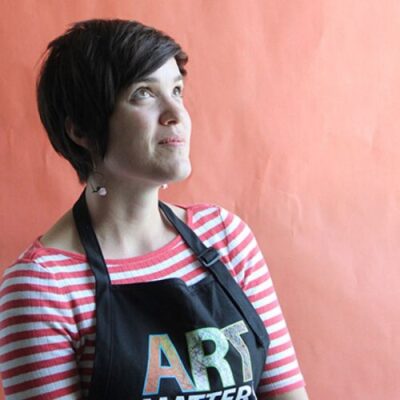Estrada shares her passion for promoting the arts in the community and inspiring creative confidence in students
This year, BYU assistant professor of art education Tara Carpenter Estrada was recognized as Higher Education Educator of the Year by the Utah Art Education Association (UAEA).
“I was honored to be named Higher Ed Art Educator of the Year,” said Estrada. “I’m grateful for my association with UAEA, through which I’ve been able to meet and learn from inspiring teachers throughout the state.” Estrada was recognized as an outstanding teacher for her efforts to build confidence in her students at BYU and to enrich the community at large.

Estrada is the creator and director of Jumpst(ART). Originally called “Art Buddies,” the program — now in its fourth year — offers after-school and summer art classes to local K-12 students, taught by BYU students and hosted on campus. The program gives local children an outlet for creative exploration through art, and also allows art education student teachers to have firsthand experience teaching children.
“A lot of education classes are theoretical — you’ll learn how to teach, but then you don’t actually get to try it out. It’s very different when you’re actually working with kids,” said Estrada. “Our students get to plan their lessons, practice teaching them, and then reflect on how it went and adjust and do it again.” Art education students in Estrada’s class spend the first few weeks working with different media and finding activities to incorporate into their classes. With her guidance they create a lesson plan, which they use as a jumping-off point to get feedback from the children about what they want to learn. Children and student teachers also have the advantage of working in small groups. With 40 to 50 children participating in the program each semester, each BYU student works with the same two to four children for eight weeks.
“They’re able to get a feel for each child’s personality and how they react to things, and we troubleshoot problems by reacting in positive ways,” said Estrada. “They also get to see kids’ art, which I think is in a lot of ways more creative and spontaneous than adults’.” One of Estrada’s main goals is to cultivate what she calls “creative confidence” in her students. This involves reframing self-criticism in positive ways to maintain a constructive approach to their progress as artists and teachers.

“I have a rule in class that my students can’t say anything negative about their own work. They have to rephrase,” said Estrada. “Students may not be excellent at every project that we do, but I hope by the end of class, they feel like they can approach new art-making techniques and try them out.” Only certain sections of Art for Elementary Teachers (ARTED 326) work with Jumpst(ART), but the course can also be taken as a General Education class. "When we offer scholarships — and kids that wouldn't normally get to take art can — I think that's a win for society."
“It’s a great option if you want to dive into lots of different art-making techniques, and also figure out how to work with kids,” said Estrada. “Regardless of what you do later — whether you’re in teaching, or you’re a parent, an aunt or a friend — I think being able to interact with young people is an important life skill. Kids are very different from adults, and they react differently to the world.”
Estrada cares about making art accessible to children who wouldn’t otherwise have access to art classes, and Jumpst(ART) offers scholarships and adjusted costs based on financial need. “In Utah, there isn’t a visual arts teacher in every school. We have a lot of really great art teachers out there, but there’s just not enough funding for every kid to get access to visual arts,” said Estrada. “When we offer scholarships — and kids that wouldn’t normally get to take art can — I think that’s a win for society.”
